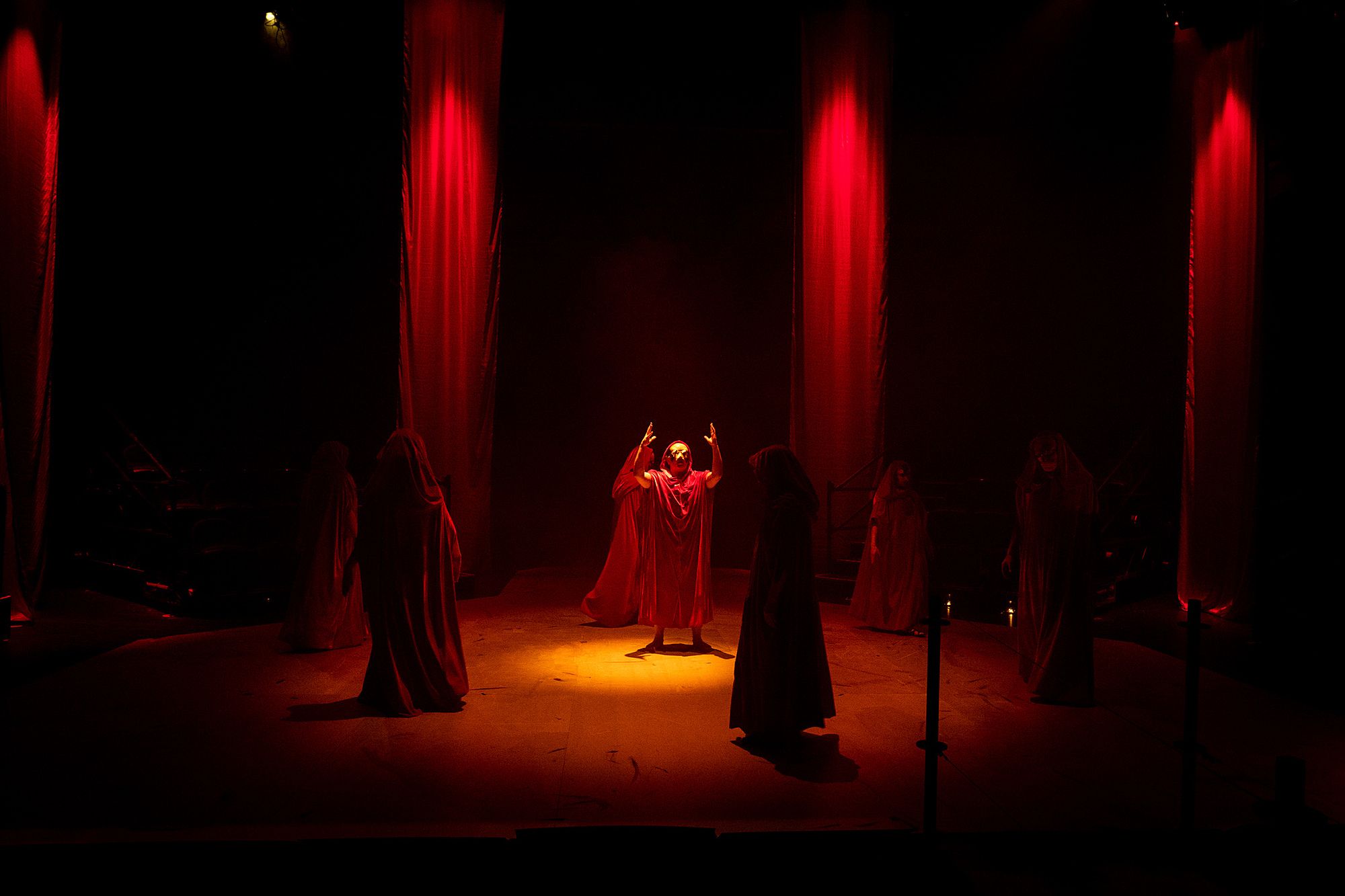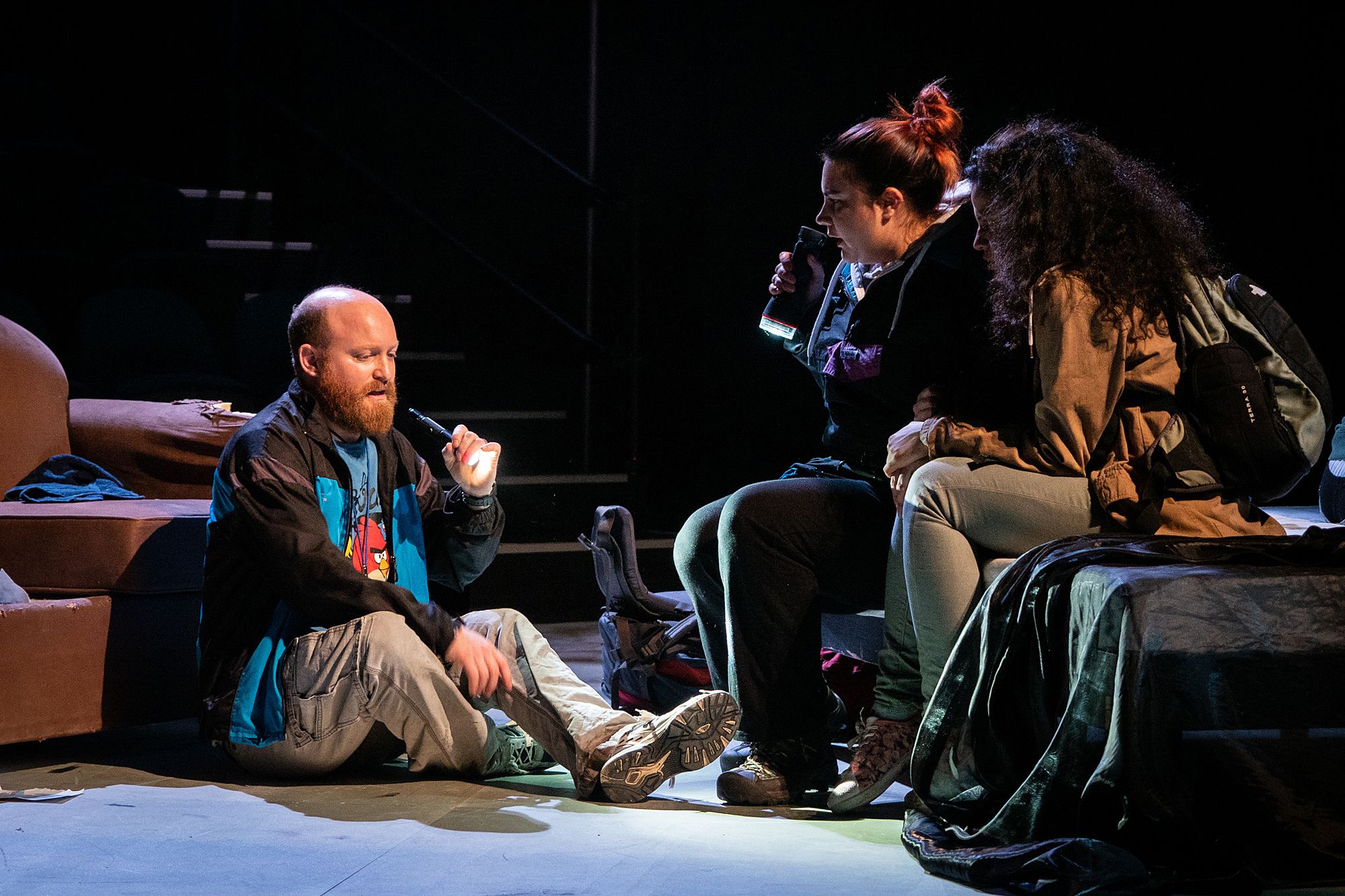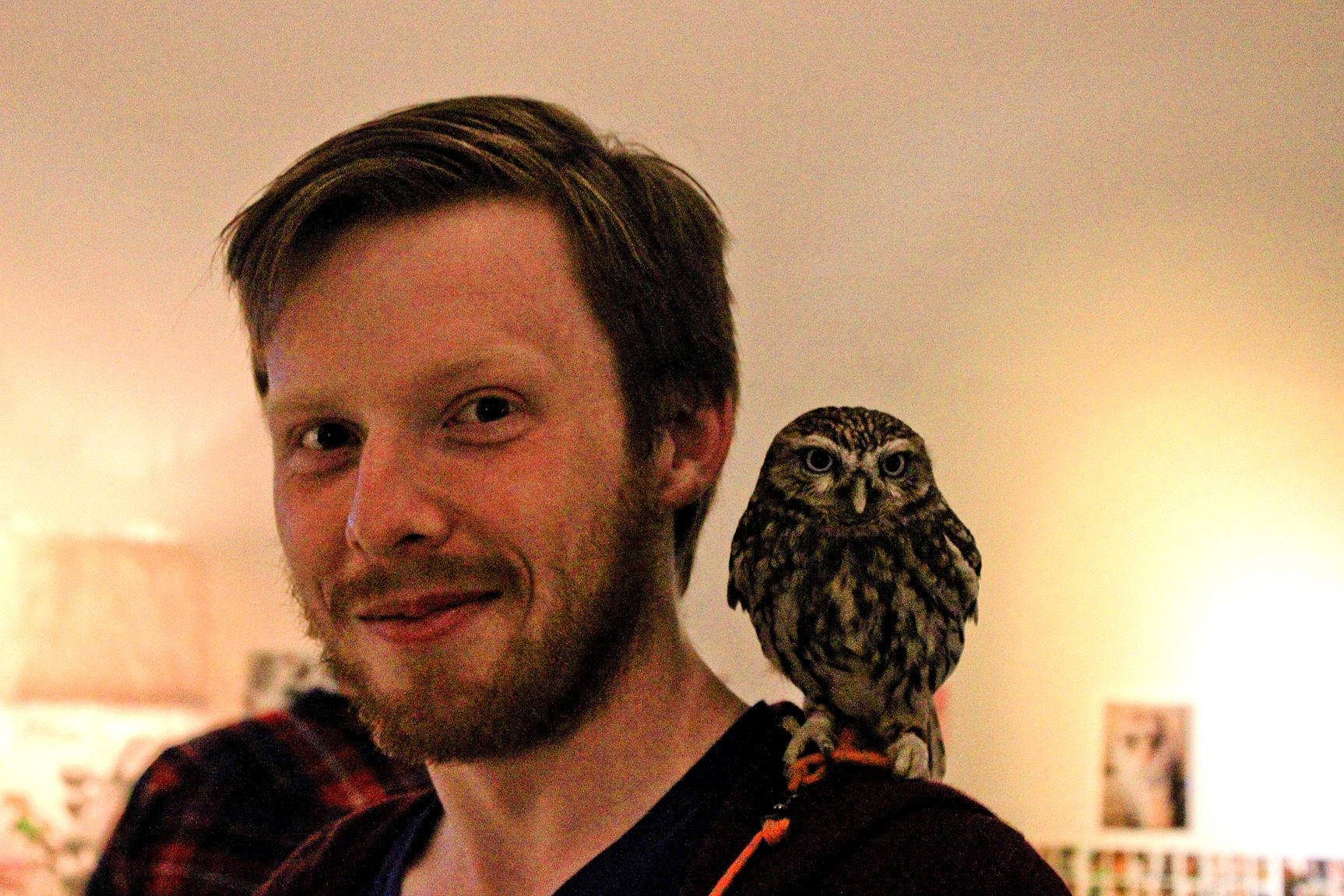Welcome to Terror Lake
Adam Goodall takes a look at Mr. Burns: A Post-Electric Play, a play about The Simpsons but also about a more existential horror.
What happens to our culture when the world starts to burn? Anne Washburn's Mr. Burns: A Post-Electric Play playfully explores this question through the lens of one of The Simpsons' most iconic episodes, Cape Feare. Adam Goodall takes a look at the play... and considers the existential horror bubbling underneath.
The world’s in a pretty bad state.
Levels of carbon dioxide in the atmosphere hit 411 parts per million units of air in May. That’s the highest level ever recorded. NASA predicts that unless drastic action is taken, we’ll enter a “new geologic era” of rising temperatures and extreme climate events caused by our own consumption.
Almost ninety percent of the world’s fisheries are fully-fished or overfished. Sea ice is melting at a massive rate and sea levels are rising with it. Our oceans are stuffed with plastic – eight million new tonnes enter the ocean each year – and ocean acidification, fuelled by climate change, threatens to destroy our marine ecosystems.
This past August, Australian National University professor Eelco Rohling told The Monthly that if we don’t rapidly reduce our CO2 emissions we’re going to make Earth “unliveable”. The 2016 Paris Agreement was supposed to be a positive step toward reducing those emissions, but according to a report published last year by Climate Action Network Europe, “no country” – not even Aotearoa New Zealand, especially not Aotearoa New Zealand – “is doing enough” to meet their Paris targets.
“And I think it was Bill Gates, the other day, who released a thing… he put out a [press release] saying that the pandemic is coming,” Mr. Burns: A Post-Electric Play director Oliver Driver tells me. “Obviously, when you do a play like this, you research the bejeezus out of it, pandemics and all that scary stuff,” he says, “and he’s going, it’s not if it’s when, y’know? Thirty million people will be wiped out by some kind of virus or pandemic, the more we blast into the forests and the more that we screw with the animals and destroy them.”
And this is all assuming we don’t get nuked.
The apocalypse we’re marching toward isn’t all that different to the global radioactive wasteland that New York playwright Anne Washburn imagines in Mr. Burns: A Post-Electric Play. In Mr. Burns, nuclear power plants across the United States have melted down. Towns have been razed to the ground, either by the explosions or by the wildfires that followed. People are getting sick and hungry and desperate and violent.
“The subject matter of it is extreme, in terms of most of the population being dead and you’ve got these few survivors,” Driver says, “but it’s not massively out of the realms of possibility.”
Mr. Burns wrestles with a question that apocalypse stories often leave untouched, though: what happens to our art after the end? This is a post-electric world without televisions and computers and theatre lights. Libraries and galleries have been burned down, walkmans are running on dying batteries, centuries worth of culture is trapped, inaccessible, on broken electronic machines.
“If you lose culture,” asks lighting designer Rachel Marlow, “what do you reference? What do you use to get through things and what do you use to give your life meaning beyond just running around trying to survive?”
In Mr. Burns, the survivors use their memories. That’s where we open: a “warm night in early October”, a campfire in a bombed-out theatre, a group of survivors trying to remember Cape Feare, a classic episode of the legendary animated sitcom The Simpsons.
MATT
...But before the court case. At the end of that sequence. You see uh a ketchup bottle spurting ‘die Bart die’ onto a letter it’s a reveal and it’s Sideshow Bob
MARIA
Sideshow Bob...
JENNY
Right. Played by Kelsey Grammer.
MATT
And then he tastes – yeah, played by Kelsey Grammer and then he tastes
MARIA
Isn't Sideshow Bob the one with (Her hands twirl briefly to indicate cascades of sproingly dreadlocks.) the hair
MATT
The hair. Yes. Sideshow Bob is
JENNY
A clown.
MATT
A clown gone wrong. Very very wrong.
MARIA
Okay but I thought. Mr. Burns. And a fish? A fish with three eyeballs?
MATT
(Takes a microsecond to process this.)
Blinky? No. No. That's a whole other episode.
JENNY
Mr. Burns runs the nuclear power plant.
MARIA
No I know that, but I thought – oh nevermind.
MATT
You're thinking of the episode where the nuclear power plant is polluting the Springfield river. But Burns doesn't try to kill him. Not in that episode.
MARIA
“Ex-cellent”, right?
She flutters her fingers uncertainly.
MATT
“Ex-cellent”
He tents his expertly.
It’s a game of cultural Telephone that’s immediately familiar to anyone who’s ever sat around with friends all talking about the shit they like. “That’s something I’ve done with my friends many a time,” says composer Leon Radojkovic. “I recognised this, and it’s such an interesting thing, to take that everyday joking around with your friends, recalling your favourite lines, trying to remember lines, misremembering them, correcting each other – taking that kind of everyday activity and then placing it in this really serious, high-stakes situation.”
When we return to those survivors seven years later, that game of Telephone has evolved into a full-on post-capitalist economy. Ramshackle theatre companies have popped up around the country, recreating the movies and television shows that they remember. (There are companies that do Shakespeare, too, but they really suck.) Everybody else barters with the theatre troupes, offering new lines and forgotten scenes in exchange for food and supplies.
Matt, Jenny, Maria and the others from the first act have banded together to form one of these companies. Cape Feare, the episode they recalled to cope with the end of the world, has become a very literal mechanism for their survival: they perform Cape Feare in their theatre, complete with ad breaks and musical interludes, for paying customers who are also trying to cope with the end of the world.
In an essay for The Brooklyn Rail, playwright and critic Emily DeVoti writes that, “Visions of the apocalypse are like visions of utopia—they reflect the waking reality, sleeping fears, and active fantasies of the creator.” Washburn’s apocalypse reflects her optimism about the place of theatre in our society, for sure: “Leave it to a playwright,” De Voti says, “to envision the post-apocalyptic world as a place where theater returns to the center of culture: a hearth around which people can gather and indulge in their fears in the safety of a community.”
But a good apocalypse does more than just reflect the hopes and anxieties of their creator. A good apocalypse, one that really gets under your skin, roots itself in the things that scare the shit out of all of us. A good apocalypse exploits our very real fear that the end of the world is inevitable, and that we, humanity, might have made it so. A good apocalypse shows us what our hope counts for: nothing, pretty much.
“The subject matter of it is extreme, in terms of most of the population being dead and you’ve got these few survivors,” Driver says, “but it’s not massively out of the realms of possibility.”
In apocalyptic books, movies and radio plays like John Carpenter’s The Thing and Cormac McCarthy’s The Road, our heroes can’t do anything to turn the tide. The Thing, for example, is “exquisitely constructed,” Jonathan Lake Crane writes in his book Terror and Everyday Life: Singular Moments in the History of the Horror Film, “to deny every attempt, from the pathetic to the brilliant, on the part of its supposed protagonists to master their world.... When they perform superbly, they die. When they screw up, they die. Whatever happens, they die.”
The apocalypse doesn’t work according to our rules. It defies our logic and it makes our knowledge of how the world works totally worthless, assuming it hasn’t destroyed it all already. When you’re haunted by a nuclear apocalypse and all that comes with it – radioactive contamination, wildfires, power plants lying dormant, friends and families lost forever – you can’t just rebuild what you had.
Mr. Burns keeps returning to how scary it is that we each individually know so little about what’s going to happen when we lose control of things we never really knew how to control in the first place. “When all of the experts have gone,” director Oliver Driver asks, “if you get seven people together in a room and go, ‘how safe is a nuclear power plant?’ We just don’t know and everybody’s got a different idea. ‘Oh, I think radioactivity stays radioactive for a million years, or maybe it’s a hundred thousand, but I think it’s all contained...’”
Mr. Burns shows us our nuclear apocalypse, but it might as well be an apocalypse by emissions, or bacteria, or a vainglorious fascist president with nukes. So what happens when things break bad? What do you do when logic stops working the way it should and your world falls down around your ears?
Well, we try to escape. “It really seemed to me,” Washburn told On The Media, “that seven years after the apocalypse people are going to want what’s certain and what’s reassuring and what reminds them very solidly of the old time. So the value for entertainment at that time is not going to be in creative expression or commentary on the moment. The value is going to be on the troupe which can pull together the most exacting replica of a cartoon possible.”
The survivors in Mr. Burns turn to The Simpsons and club bangers and half-remembered ads about cars and bath salts. They rebuild their dead culture as a coping mechanism, so they don’t have to talk about radiation poisoning or starvation or murder. They escape to escapism. “No motivation, no consequence, that’s the point of a cartoon,” Quincy argues in the second act. “Where else do we get to experience that, nowhere.”
But that fear of the unknown bleeds into their work. It’s there in the lunch thief in the Brand New Woman ad, and in the troupe’s argument over whether the wine in that ad should be Chablis or Shiraz. And in the musical extravaganza of a third act, seventy-five years later, that fear lives in a Satanic monster called ‘Mr. Burns’. He’s pitiless, unstoppable, unkillable, unknowable. He’s like Freddy or Jason or Max Cady or Reverend Harry Powell – all iconic horror villains referenced in the original Cape Feare episode – but he’s also much much more than any of them. He’s a divine terror; this post-apocalyptic society has taken all the pain it’s suffered and put it into him.
A good apocalypse exploits our very real fear that the end of the world is inevitable, and that we, humanity, might have made it so. A good apocalypse shows us what our hope counts for: nothing, pretty much.
Nearly a century later, The Simpsons is no longer cozy or welcoming, like a bed that makes you feel like a big toasty cinnamon bun. It’s no longer an escape. Logic has failed. Knowledge has failed. Meaningless Entertainment has failed. The survivors reinterpret The Simpsons like we reinterpret Shakespeare, and so Springfield becomes a vessel to carry a new generation’s fear, suffering and hope. By rebuilding their dead culture to protect them from the realities of their new world, the survivors have created a new culture, full of Meaning.
Back in February, Anne Washburn told On the Media that she had “many bossy opinions on the topic of what it is for humans to handle a technology they actually are demonstrably unable to control”:
Nuclear power is completely safe, as long as there is no human failure of any kind, no infrastructure failure of any kind. It’s completely safe as long as it is controlled by a civilization which progresses continuously with, you know, smooth segues from one civilization to the next for a period of about 10,000 years. And that's something which has never happened in the history of human beings.
Mr. Burns is about nuclear, but it also has something to say about us – our hubris, our hope, our impulse to look for an escape instead of dealing with the problems right in front of us. Because we won’t be able to escape the apocalypse, when it hits, and we won’t be able to rebuild what we had. You could try. You could try and remake society, re-establish order, even revive The Simpsons. But none of it’s going to be what you remember.
Mr. Burns: A Post-Electric Play runs from September 13-29 at Q Theatre Rangatira. Tickets available here.
This piece is presented as part of a partnership with Silo Theatre and appears in the show programme. Silo cover the costs of paying our writers while we retain all editorial control.
Production images: Andrew Malmo.




